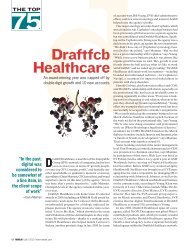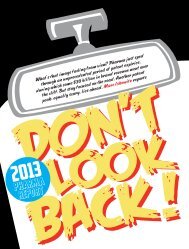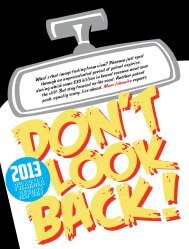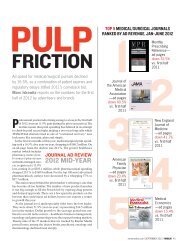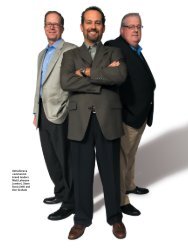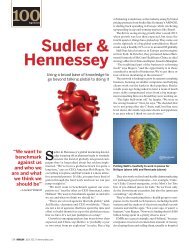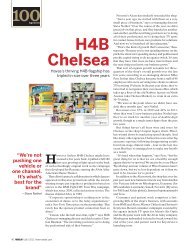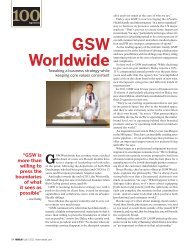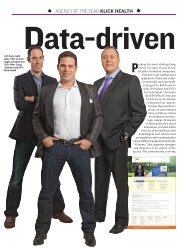Create successful ePaper yourself
Turn your PDF publications into a flip-book with our unique Google optimized e-Paper software.
the<br />
<strong>DtC</strong>:<br />
BEYOND<br />
BLOCK-<br />
BUSteR<br />
The mass-market, TV-<strong>and</strong>-print DTC formula is going the way of the vanishing<br />
primary care blockbusters it was designed to boost as new media <strong>and</strong> niche<br />
products fill the breach, Matthew Arnold reports<br />
The prescription drug ads of tomorrow won’t interrupt our favorite TV show to<br />
suggest that we ask our doctor about some pill to treat a condition we probably<br />
don’t have, <strong>and</strong> they won’t take us on scenic walks through summer meadows<br />
or along pristine beaches. More likely than not, they’ll be promoting specialty drugs<br />
<strong>and</strong> biologics indicated for treatment of exactly the diseases we do have. They’ll be<br />
hyper-targeted <strong>and</strong> hyper-specific.<br />
The media world is transforming at a blistering pace, with much of the action shifting<br />
from TV to Web to mobile <strong>and</strong> social just in the past few years, <strong>and</strong> ad spend (along<br />
with prices) catching up but still well behind the times. At the same time, the profile of<br />
br<strong>and</strong>ed drugs is changing with equal rapidity as the mass-market blockbusters that<br />
served as the engine of industry revenues for the past decade go off-patent <strong>and</strong> are<br />
replaced by an array of smaller products, including biologics, vaccines, devices <strong>and</strong><br />
diagnostics.<br />
Of the 20 biggest advertisers among prescription drug br<strong>and</strong>s of 2011, two have<br />
already gone off patent, including top-spending Lipitor ($220 million for the year)<br />
<strong>and</strong> AstraZeneca’s Seroquel XR ($94 million). Bristol-Myers Squibb/Sanofi’s Plavix,<br />
which spent $75 million for the 12 months to September, loses patent exclusivity next<br />
month. Five years from now, br<strong>and</strong>s that spent $1.2 billion on measured DTC media in<br />
2011, according to Nielsen data, will have lost patent protection. Almost all of those<br />
products will face generic competition, the exceptions being biologics like Pfizer/<br />
Amgen’s Enbrel <strong>and</strong> drug-device combos like Glaxo SmithKline’s Advair Diskus.<br />
36 MM&M x APRIL 2012 x mmm-online.com<br />
Flask from Takeda’s Uloric campaign
PHOTO: KEVIN LOCK<br />
John Miles,<br />
Pfizer VP, sales<br />
<strong>and</strong> marketing,<br />
Enbrel in the<br />
US (left) with<br />
Dominique<br />
Monnet,<br />
Amgen general<br />
manager,<br />
inflammation<br />
business unit<br />
mmm-online.com x FEBRUARY 2012 x MM&M 00
<strong>DtC</strong>: BeYOND the BLOCKBUSteR<br />
There will be new products,<br />
of course, to replace those<br />
going generic. Consumers will<br />
still need to be educated on<br />
their conditions <strong>and</strong> treatment<br />
options. Manufacturers will still<br />
do much of that through good<br />
old-fashioned advertising. But<br />
the drugs <strong>and</strong> biologics coming<br />
down the pipeline are very different<br />
from the old mass-market,<br />
primary care-focused, strictly<br />
small-molecule blockbusters of<br />
old, <strong>and</strong> marketing them—to<br />
smaller audiences, using smaller<br />
budgets—will require a whole<br />
new set of tools.<br />
Fortunately, they’re set to<br />
hit the market just as emerging<br />
digital technologies make more<br />
precise targeting possible <strong>and</strong>,<br />
compared to buying airtime,<br />
more affordable.<br />
Enbrel’s example<br />
Enbrel straddles the old <strong>and</strong> the<br />
new in DTC. On the one h<strong>and</strong>,<br />
the Pfizer/Amgen joint venture is<br />
a mature mega-blockbuster that’s made<br />
its makers tens of billions of dollars over<br />
the 14 years it’s been on the market. On<br />
the other, it’s a complex biologic injectable,<br />
<strong>and</strong> people with the various immunological<br />
disorders it treats are far less<br />
numerous than, say, sufferers of seasonal<br />
allergies, insomnia or depression.<br />
“What you find here is a much more<br />
targeted approach in terms of knowing<br />
your customer <strong>and</strong> how best to communicate<br />
to them, via what channels,” says<br />
Pfizer’s John Miles, VP of<br />
sales <strong>and</strong> marketing for<br />
Enbrel in the US. “We use<br />
a very integrated approach<br />
with Enbrel. It’s not completely<br />
novel—we’re using<br />
TV <strong>and</strong> print as you would<br />
normally see it—but where<br />
we go into the digital space,<br />
there are opportunities where<br />
we know who our customers<br />
are, <strong>and</strong> we’re very specific in<br />
types of initiatives, whether it’s<br />
search or display advertising.<br />
We know where our patients<br />
<strong>and</strong> physicians are.”<br />
For Enbrel, Pfizer <strong>and</strong><br />
Amgen are currently running<br />
38 MM&M x APRIL 2012 x mmm-online.com<br />
Br<strong>and</strong>ed ads from DTC campaigns for Takeda gout drug Uloric (top),<br />
Vertex hepatitis C product Incivek (middle) <strong>and</strong> Pfizer/Amgen biologic<br />
Enbrel<br />
a campaign rooted in a venerable<br />
old tactic—the celebrity sufferer,<br />
in this case pro golfer Phil<br />
Mickelson, who revealed in 2010<br />
that he had been diagnosed with<br />
psoriatic arthritis <strong>and</strong> prescribed<br />
the biologic. The companies<br />
launched a campaign featuring<br />
Mickelson last November,<br />
with AbelsonTaylor h<strong>and</strong>ling<br />
creative.<br />
“Phil is such an inspiring<br />
spokesperson for patients with<br />
psoriatic arthritis, <strong>and</strong> it’s a condition<br />
that has not received a tremendous<br />
amount of press,” says<br />
Dominique Monnet, VP general<br />
manager of the inflammation<br />
business unit at Amgen.<br />
Psoriatic arthritis afflicts<br />
around one in twenty of the 2%<br />
of Americans who<br />
suffer from psoriasis.<br />
As with other<br />
rheumatic conditions,<br />
the disease is<br />
under-diagnosed<br />
<strong>and</strong> treated, <strong>and</strong><br />
as with rheumatoid<br />
arthritis,<br />
early intervention<br />
is critical<br />
to prevent permanent<br />
joint<br />
damage.<br />
Enbrel is<br />
indicated for<br />
five conditions,including<br />
psoriatic<br />
arthritis, plaque<br />
psoriasis, rheumatoid arthritis,<br />
juvenile idiopathic arthritis <strong>and</strong><br />
ankylosing spondylitis. Altogether,<br />
rheumatoid diseases<br />
affect around 1% of the US<br />
population. The joint venture<br />
has also recently launched a<br />
separate campaign aimed at<br />
sufferers of plaque psoriasis.<br />
The br<strong>and</strong>.com bridges all<br />
the indications.<br />
“You’re dealing with<br />
different patients with<br />
these indications, so it’s<br />
important that we really<br />
look at the different<br />
channels available to
Top 20 companies by DTC spending, 2011<br />
Rank Company US DTC % change vs.<br />
media $ (000s)* prior year<br />
1 Pfizer $885,990.7 -2%<br />
2 Eli Lilly $445,111.3 6%<br />
3 AstraZeneca $340,091.5 -8%<br />
4 GlaxoSmithKline $204,932.7 -36%<br />
5 Boehringer Ingelheim $190,297.6 135%<br />
6 Merck $186,855.6 -17%<br />
7 Abbott Labs $182,572.6 39%<br />
8 Allergan $158,767.5 -6%<br />
9 Amgen $140,915.9 111%<br />
10 Otsuka $134,927.7 -14%<br />
11 Takeda $112,370.5 71%<br />
12 Novartis $100,307.5 52%<br />
13 Bristol-Myers Squibb $84,341.9 -16%<br />
14 Sumitomo $74,467.4 -12%<br />
15 Novo Nordisk $70,289.2 348%<br />
16 Bayer $66,130.9 -19%<br />
17 Roche $64,223.3 -29%<br />
18 Johnson & Johnson $56,150.1 -55%<br />
19 BMS/Sanofi $50,100.3 -61%<br />
20 Sanofi $45,051.7 -12%<br />
*Total spend comprises broadcast, print, outdoor <strong>and</strong> B2B, but not digital<br />
Source: Nielsen<br />
us <strong>and</strong> communicate appropriately to them,” says Miles. “So we<br />
have a clear direction with rheumatology <strong>and</strong> a really clear but<br />
independent direction with our dermatology approach.”<br />
Niche br<strong>and</strong>s, big plays<br />
J&J’s Janssen Biotech is using aspirational messaging—along with<br />
a bit of star power—to promote its Stelara for plaque psoriasis.<br />
“Psoriasis patients suffer from a range of physical, emotional<br />
<strong>and</strong> treatment burdens related to their condition,” says Janssen<br />
Biotech’s David Fabbri, director of dermatology marketing, “so<br />
our main goal is to instill hope for clearer skin. With that in mind,<br />
all our messaging focuses on the idea that they can ‘imagine the<br />
possibilities of clearer skin.’”<br />
In addition to br<strong>and</strong>ed ads <strong>and</strong> a website touting its “Stories”<br />
testimonials, including that of America’s Next Top Model winner<br />
CariDee English, the Stelara team is also running an unbr<strong>and</strong>ed<br />
education campaign, developed in partnership with the National<br />
Psoriasis Foundation, called “Are You Serious?” The effort, which<br />
launched at the end of 2010 with a humorous viral video starring<br />
comedian <strong>and</strong> sufferer Jon Lovitz, includes a patient-focused online<br />
platform soliciting stories of coping with the disease from patients.<br />
Draftfcb Chicago h<strong>and</strong>led creative for the campaign featuring Cari-<br />
Dee, while Universal McCann’s J3, Ansible <strong>and</strong> Razorfish worked on<br />
other aspects of the campaign. Tonic Life Communications worked<br />
on “Are You Serious?”<br />
Stelara also hosts “Fit in Your Skin,” an online health <strong>and</strong> wellness<br />
uErosTo commodo odioNul<br />
Top 20 br<strong>and</strong>s by DTC spending, 2011<br />
Rank Br<strong>and</strong> Company US DTC media % change vs.<br />
$ (000s)* prior year<br />
1 Lipitor Pfizer $220,823.6 -12%<br />
2 Cymbalta † Eli Lilly $166,165.5 N/A<br />
3 Cialis Eli Lilly $143,765.9 -20%<br />
4 Abilify BMS $131,242.1 0%<br />
5 Viagra Pfizer $127,584.9 23%<br />
6 Celebrex Pfizer $114,218.1 234%<br />
7 Pradaxa BI $108,893.2 N/A<br />
8 Cymbalta †† Eli Lilly $104,231.9 -45%<br />
9 Lyrica Pfizer $103,223.3 4%<br />
10 Enbrel Pfizer/Amgen $99,604.4 163%<br />
11 Pristiq Pfizer $96,332.4 -22%<br />
12 Seroquel XR AstraZeneca $94,139.7 318%<br />
13 Uloric Takeda $93,583.5 143%<br />
14 Advair Diskus GSK $81,959.6 -23%<br />
15 Chantix Pfizer $80,484.3 -20%<br />
16 Spiriva BI $75,213.0 10%<br />
17 Crestor AstraZeneca $61,864.3 -36%<br />
18 Symbicort BI $58,599.6 -7%<br />
19 Boniva Genentech $54,078.7 -36%<br />
20 Vimovo AstraZeneca $53,693.0 162%<br />
*Total spend comprises broadcast, print, outdoor <strong>and</strong> B2B, but not digital †for pain ††for depression<br />
Source: Nielsen<br />
program for psoriasis sufferers led by fitness expert Jackie Warner<br />
(Amgen <strong>and</strong> Pfizer ran unbr<strong>and</strong>ed awareness ads early on, “when biologic<br />
therapy was new <strong>and</strong> we really needed to educate patients,” says<br />
Pfizer’s Miles, but have since shifted to a strictly br<strong>and</strong>ed approach).<br />
From Q4 ’11 to Q3 ’12, Stelara spent $71 million.<br />
Like Stelara, Takeda’s Uloric launched recently. As the first new<br />
product for gout on the market in four decades, the Uloric team<br />
had some work to do in educating patients about how the disease<br />
works <strong>and</strong> available treatments.<br />
“Our campaign was really focused on targeting patients who<br />
were on treatment but were still experiencing flares,” says Heidi<br />
Gillmore, marketing director for Uloric. “There was a big awareness<br />
gap because of the fact that there’s been no new innovation in the<br />
category for decades, <strong>and</strong> therefore no promotion happening. There<br />
was really a lack of credible resources on the Internet.”<br />
While the disease is most often treated by primary care physicians,<br />
the market for gout drugs is a niche one, with around eight million<br />
adults diagnosed in the US, <strong>and</strong> just short of three million treated<br />
chronically. Because there’s a lot of co-morbidity, the topic often fails<br />
to come up during doctor visits, as more immediate health concerns<br />
predominate. Around half of those on treatment are still experiencing<br />
flares, according to Takeda’s research, which also found poor<br />
patient underst<strong>and</strong>ing of the role of hyperuricemia, the underlying<br />
metabolic condition treated by Uloric, in gout.<br />
“So that fed into our strategy behind doing a really broad-based,<br />
multichannel, br<strong>and</strong>ed <strong>and</strong> unbr<strong>and</strong>ed campaign to both educate<br />
mmm-online.com x APRIL 2012 x MM&M 39
<strong>DtC</strong>: BeYOND the BLOCKBUSteR<br />
on the disease state <strong>and</strong> introduce the br<strong>and</strong> as an option to these<br />
patients,” says Gillmore. Takeda took a two-pronged approach,<br />
the unbr<strong>and</strong>ed fork being ads that featured a real doctor talking<br />
about the role that uric acid plays in gout along with the tagline<br />
“Gout can attack silently even between flares.” Br<strong>and</strong>ed ads feature<br />
patients lugging around a large flask of liquid that serves as<br />
a metaphor for uric acid reduction. Both efforts drive viewers to<br />
goutinfo.com. The br<strong>and</strong> is now moving to put more emphasis on<br />
relationship marketing.<br />
“Now that we’ve built this awareness level, we’re really trying to<br />
drive more dialogue between patients <strong>and</strong> physicians,” says Gillmore.<br />
“So we’re starting to step away from the awareness-building vehicles<br />
like the TV ads <strong>and</strong> center more on the action vehicles—online <strong>and</strong><br />
in-office media.”<br />
Gout is one of the most-searched conditions, says Gillmore, <strong>and</strong><br />
Takeda research has shown that four out of five patients searching<br />
for gout info online are currently suffering a gout attack.<br />
“They’re having pain <strong>and</strong> they’re trying to seek out solutions at<br />
that time, so we really try <strong>and</strong> leverage that as much as possible,<br />
because that was something we identified at our launch that, because<br />
of the lack of innovation in the category, there was a lack of credible<br />
resources on the Internet for patients to turn to. So you search on<br />
‘gout’ <strong>and</strong> you’re getting a lot of home remedies <strong>and</strong> those types<br />
of things.”<br />
Takeda’s Gout.com is the destination for its unbr<strong>and</strong>ed efforts,<br />
while its Gout Smart program offers interactive discussion guides<br />
<strong>and</strong> other features aimed at getting patients into treatment.<br />
Fine-tuning the consumer channel<br />
Part of what’s opening up the consumer channel to br<strong>and</strong>s with<br />
smaller audiences is the availability of tools that facilitate much<br />
more precise targeting.<br />
“There’s been an evolution in the tools available <strong>and</strong> how we<br />
approach media,” says Novo Nordisk’s Jeremy Shepler, associate<br />
director, marketing. “While zero waste is never going to be something<br />
any marketer can achieve, it’s certainly something we can strive for,<br />
<strong>and</strong> what’s being offered today allows us to become much more<br />
targeted. I don’t want to say syndicated research is out the door,<br />
but things have evolved.”<br />
Newer entrants like TRA <strong>and</strong> Crossix are shaking up the measurement<br />
<strong>and</strong> analytics game, offering advertisers a means of getting closer<br />
to their targets. For example, through a partnership with IMS Health,<br />
TRA can match its TV set top box data to prescriber-level data telling<br />
them what drugs an (anonymized) household is taking.<br />
“That tool is now given to our media agency, which allows them to<br />
pick the best mix, whatever it may be, to make sure we’re in front of<br />
the people most meaningful to us,” says Shepler. “And on the back<br />
end, we can now look at people exposed to our advertising <strong>and</strong> do<br />
ROI-based network-level buys. We can go back <strong>and</strong> see at what<br />
point we lose people <strong>and</strong> where we have the greatest conversion<br />
rate. This is fundamentally different from how media agencies have<br />
bought in the past.”<br />
At the same time, so-called dem<strong>and</strong> service providers, or DSPs,<br />
operate as virtual auctioneers of media inventory, making instantaneous<br />
buys at the lowest price, much as today’s electronic stock<br />
exchanges allow for automated trades at light speed.<br />
Health portals are pressing their advantage with innovative targeting<br />
technologies. Novo Nordisk likes QualityHealth, which offers<br />
40 MM&M x APRIL 2012 x mmm-online.com<br />
During 2011, DTC ad spend across all media<br />
(excluding Web) fell 1%<br />
5<br />
4<br />
3<br />
2<br />
1<br />
0<br />
Source: Nielsen<br />
$4.7B<br />
$4.3B $4.3B<br />
$3.9B $3.9B<br />
2007 2008 2009 2010 2011<br />
a pay-for-performance model <strong>and</strong> targeting by users’ condition,<br />
symptoms <strong>and</strong> product usage.<br />
“Ultimately, with DTC, what people are trying to do is get those<br />
consumers to go to the doctor <strong>and</strong> ask about their br<strong>and</strong>,” says<br />
QualityHealth CEO Rob Rebak, “<strong>and</strong> the math they’re trying to<br />
get back to is the cost-per-br<strong>and</strong>-request.” For digital, says Rebak,<br />
that cost is a quarter of what it would be in a broad-based TV <strong>and</strong><br />
print campaign.<br />
The cost pressures on advertisers will be all the more intense<br />
this year as the Olympics <strong>and</strong> the presidential election conspire to<br />
drive up prices, particularly for TV. Vertex is dispensing with TV ads<br />
altogether with its DTC launch of hepatitis C drug Incivek.<br />
“If we were in a highly prevalent disease we would [use TV],<br />
because that’s a good way to reach a broad population, but here,<br />
the approach is really reaching a more targeted audience,” says<br />
Pamela Stephenson, VP, Incivek marketing, at Vertex. For Incivek,<br />
Vertex is focusing on digital media—paid search <strong>and</strong> banner ads—<br />
along with print ads “geotargeted” to cities with a high prevalence<br />
of the disease.<br />
“Because [hep. C] is a complicated disease, we’ve spent a lot of<br />
time researching <strong>and</strong> talking to patients, trying to underst<strong>and</strong> how<br />
to explain the disease <strong>and</strong> the therapy best suited to them,” says Stephenson.<br />
Part of the challenge for Incivek was raising awareness that<br />
the virus could be cured. In surveys <strong>and</strong> focus groups, Vertex found<br />
widespread confusion about the definition of “cure” in the context of<br />
the category, so they spelled it out (the virus being undetectable in the<br />
blood six months after treatment), taking a health literacy approach.<br />
“In these highly technical fields, you have to do your homework <strong>and</strong><br />
spend time with patients,” says Stephenson. “Once we explained it<br />
<strong>and</strong> people understood it, it was highly motivating.”<br />
Vertex also gleaned some important insights into the psychology<br />
of the disease. Patients, Stephenson’s team learned, were sick<br />
of feeling blamed for having contracted hep. C. The result was the<br />
“Fighter campaign,” with creative by Extrovertic <strong>and</strong> digital by<br />
Ignite Health. Creative features images of real patients in martial<br />
arts poses <strong>and</strong> the tagline: “You didn’t ask for hepatitis C.” The<br />
message is one of empowerment.<br />
“It’s very authentic,” says Stephenson. “It’s real people st<strong>and</strong>ing up<br />
to their disease. And it’s very different from other pharma advertising<br />
that shows a lot of happy people. When we showed them smiling<br />
faces, it didn’t resonate. They said, ‘That’s not me.’” n



